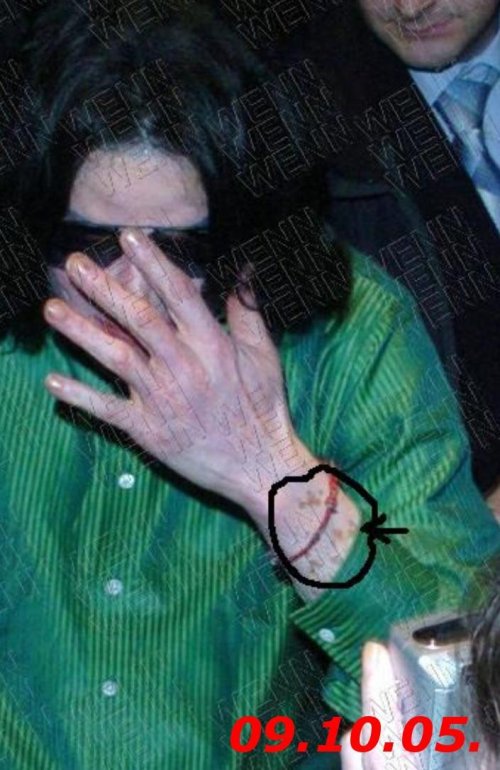In first place let's take Michael's kids. Is it possible to Michael be their biological father? Yes, of course:
1.Vitligo is a hereditary disease. It's been confirmed on October 2009 by Latoya and Karen Faye (Michael's make-up artist), that Prince Michael I has vitiligo as well.
2.Michael's pigment was most weakness by Vitiligo.
3.Their mother Debbie Rowe is white, it means pigment of black skin is weakness in this situation.
All this mean, Michael's kids are really his biological children.
Vitiligo or leukodermia is a chronic skin condition that causes loss of pigment, resulting in irregular pale patches of skin. The precise cause of vitiligo is complex and not fully understood. There is some evidence suggesting it is caused by a combination of auto-immune, genetic, and environmental factors. The population incidence in the United States is considered to be between 1% and 2%.
Signs
Half of people with vitiligo develop patches of de-pigmented skin appearing on extremities before their 20s. The patches may grow or remain constant in size. Patches often occur symmetrically across both sides on the body. Occasionally small areas may repigment as they are recolonised by melanocytes. The location of vitiligo affected skin changes over time, with some patches re-pigmenting and others becoming affected.
In some cases, mild trauma to an area of skin seems to cause new patches - for example around the ankles (caused by friction with shoes or sneakers). Vitiligo may also be caused by stress that affects the immune system, leading the body to react and start eliminating skin pigment.
Vitiligo on the scalp may affect the color of the hair (though not always), leaving white patches or streaks. It will similarly affect facial and body hair.
Disease mechanism
Vitiligo is associated with autoimmune and inflammatory diseases, commonly thyroid overexpression and underexpression. Jin in the New England Journal of Medicine reported a study comparing 656 people with and without vitiligo in 114 families, which found several mutations (single-nucleotide polymorphisms) in the NALP1 gene. The NALP1 gene, which is on chromosome 17 located at 17p13, is on a cascade that regulates inflammation and cell death, including myeloid and lymphoid cells, which are white cells that are part of the immune response. NALP1 is expressed at high levels in T cells and Langerhan's cells, white cells that are involved in skin autoimmunity.
Among the inflammatory products of NALP1 are caspase 1 and caspase 5, which activate the inflammatory cytokine interleukin-1ß. Interleukin-1ß is expressed at high levels in patients with vitiligo. There are compounds which inhibit caspase and interleukin-1ß, and so might be useful drugs for vitiligo and associated autoimmune diseases.
Of the 656 people, 219 had vitiligo only, 70 had vitiligo with autoimmune thyroid disease, and 60 had vitiligo and other autoimmune diseases.
In one of the mutations, the amino acid leucine in the NALP1 protein was replaced by histidine (Leu155->His). The original protein and sequence is highly conserved in evolution, and found in humans, chimpanzee, rhesus monkey, and bush baby, which means that it's an important protein and an alteration is likely to be harmful.
The following is the normal DNA and protein sequence in the NALP1 gene:
TCA CTC CTC TAC CAA
Ser Leu Leu Tyr Gln
S L L Y Q
In some cases of vitiligo the first leucine is altered to histidine, by a Leu155His mutation:
TCA CAC CTC TAC CAA
Ser His Leu Tyr Gln
S H L Y Q
(Leucine is nonpolar and hydrophobic; histidine is positively charged and hydrophilic, so it is unlikely to serve the same function.)
Psychological effects
Vitiligo can have a significant effect on the psychological well being of the patient. This is especially true for darker skinned patients as the contrast between pigmented and depigmented skin can be quite drastic.
In some cultures there is a stigma attached to having vitiligo. Those affected with the condition are sometimes thought to be evil or diseased and are sometimes shunned by others in the community. People with vitiligo may feel depressed because of this stigma or because their appearance has changed dramatically.
Other people with vitiligo experience no negative psychological effects at all.
Treatment
There are a number of ways to alter the appearance of vitiligo without addressing its underlying cause. In mild cases, vitiligo patches can be hidden with makeup or other cosmetic solutions. If the affected person is pale-skinned, the patches can be made less visible by avoiding sunlight and the sun tanning of unaffected skin. However, exposure to sunlight may also cause the melanocytes to regenerate to allow the pigmentation to come back to its original color.
Phototherapy is also beneficial. Exposure to long-wave ultraviolet (UVA) light from the sun or from UVA lamps, together with Psoralen, called "PUVA", can help in many cases. Psoralen can be taken in a pill 1-2 hours before the exposure or as a Psoralen bath or soaking the area before the exposure.
Lately, PUVA has been replaced with exposure to Narrowband UVB light at a wavelength of 311-313 nanometers. This treatment does not involve Psoralen since the effect of the lamp is strong enough. The source for the UVB Narrowband UVB light can be special fluorecent lamps that treat large area in few minutes, or high power fiber-optic devices in a fraction of a second.
Scientific studies have also shown that immunomodulator creams such as Protopic and Elidel also cause repigmentation in some cases, when used with UVB Narrowband treatments [2][3].
Alternatively, some people with vitiligo opt for chemical depigmentation, which uses 20% monobenzylether of hydroquinone. This process is irreversible and generally ends up with complete or mostly complete depigmentation.
In late October of 2004, doctors successfully transplanted melanocytes to vitiligo affected areas, effectively repigmenting the region. The procedure involved taking a thin layer of pigmented skin from the patient's gluteal region. Melanocytes were then separated out and used to make a cellular suspension. The area to be treated was then ablated with a medical laser, and the melanocyte graft applied. Three weeks later, the area was exposed to UV light repeatedly for two months. Between 73 and 84 percent of patients experienced nearly complete repigmentation of their skin. The longevity of the repigmentation differed from person to person.[8]
The more traditional treatment given by most dermatologists is steroids.
A fern extract Calaguala may be an effective treatment for this condition.
Famous people with vitiligo besides Michael
- Thomas Lennon, of Reno 911!, as evidenced by close-ups of his hands during the bike lock scene of episode The Investigation Continues.
- J.D. Runnels, of the Chicago Bears, has Vitiligo
- Sisqo, solo and lead singer of Dru Hill reports having vitiligo.
- Fez Whatley, of the Ron and Fez show has vitiligo patches on his face.
- Joe Rogan, also has Vitiligo.
Source: Wikipedia.com
Another fact about Michael's Vitiligo for people who still don't believe is report from autopsy which was performed after his death. During autopsy Dr. noticed and notes down that Vitiligo was on his arms, stomach and face.
















